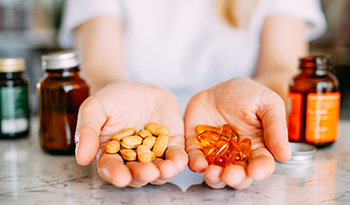Natural Herbs and Cognitive Health

Limitations of Conventional Treatments Invite Research on Herbs
Dementia is a neurodegenerative disease that causes progressive impairments in memory and learning, executive functioning and activities of daily living. There are more than 47.5 million people with dementia worldwide and 7.7 million new cases are added to the dementia pool each year. Increased risk of vascular dementia (VaD) is associated with obesity, hypertension, cardiovascular disease and cerebrovascular accidents (i.e. ‘stroke’). VaD accounts for 10 to 15% of all cases of dementia in industrialized countries and 30% of dementia cases in less developed world regions and is the second most prevalent form of dementia after Alzheimer’s disease (AD). Over 40% of vascular dementia cases also have AD neurodegenerative pathology, representing the most common type of mixed dementia.
Available pharmacologic agents such as cholinesterase inhibitors and glutamate receptor antagonists are helpful in some cases of AD but have limited efficacy against VaD. The result has been that many people with VaD are using herbs and other complementary and alternative (CAM) approaches such as acupuncture, nutraceuticals, yoga, tai chi, and music therapy.
Many herbs used in Chinese medicine have been investigated alone and in different combinations for their potential beneficial effects on symptoms of AD and VaD, including Ginkgo biloba, Huperzia serrata, Curcuma longa, Panax ginseng, Panax notoginseng, Bacopa monnieri, Salvia miltiorrhiza, Crocus sativus, and Camellia sinensis. Below is a concise review of studies on single Chinese herbs and complex Chinese herbal formulas being investigated for their potential cognitive enhancing benefits in healthy adults and individuals with dementia.
Single Herbs are Beneficial but Limited
Recent findings suggest that Ginkgo biloba extracts improve learning and memory in animal models of VaD. Large placebo-controlled studies and meta-analyses of studies that meet strict inclusion criteria for rigor support that G. biloba extract slows the rate of decline in cognition, executive functioning and behavior in individuals diagnosed with AD and VaD. Proposed mechanisms by which G. biloba enhances brain function resulting in improved memory and cognitive functioning include decreased activity of pro-inflammatory macrophages, improved blood flow, reduced activity of platelet-activating factor (which reduces stroke risk), reduced corticosteroid production and increased glucose uptake, enhancing neural stem cell proliferation, accelerating synaptic plasticity following brain injury, reducing circulating free cholesterol, and reducing brain β-amyloid precursor protein production.
Curcuma longa (turmeric) has been used for centuries in Chinese, Hindu, and Ayurvedic medicine for centuries for numerous medical disorders including pancreatitis, arthritis, cancer, and inflammatory, neurodegenerative, and digestive disorders. Animal and in vitro studies suggest that cognitive enhancing benefits of curcumin are based on multiple mechanisms of action including inhibition of lipid peroxidation, scavenging reactive oxygen species (ROS), and reactive nitrogen species, inhibition of NF-kB activation, and its anti-inflammatory actions. Curcumin may also directly bind small beta-amyloid species to block aggregation and the formation fibrillary tangles. In a 24 month randomized clinical trial 36 patients with mild to moderate AD randomized to curcumin (2 and 4gm/day) vs placebo experienced equivalent non-significant changes in cognition and memory. These findings may be due in part to the low bioavailability of the curcumin preparation used in the study.
Findings of animal studies suggest that bioactive constituents of Panax ginseng may improve cognition and memory in patients with dementia. Ginsenoside Rg5 reduces amyloid-β and cholinesterase activity, and ginsenoside Rg3 promotes β-amyloid peptide degradation via enhancing gene expression. Panax ginseng may also decrease blood pressure and improves blood circulation by enhancing vasodilation. Two open 12-week trials suggest that ginseng may improve cognition in individuals diagnosed with AD. In two recent small open trials individuals diagnosed with AD who received P. ginseng in doses of 4.5 and 9gm/day, experienced significant improvement in cognition and memory. Findings of two small placebo-controlled trials suggest that Panax notoginseng improves cerebral blood flow and enhances memory in individuals diagnosed with VaD.
Bacopa monnieri (Brahmi) has neuroprotective and antioxidant effects, works as a free radical scavenger and may increase cerebral blood flow. The herbal is widely used in Ayurvedic medicine for memory problems. Studies on cognitive enhancing benefits of the herbal in healthy adults and individuals diagnosed with AD are currently ongoing.
Saffron (Crocus sativus) is used in Chinese medicine as antidepressant, antispasmodic, and anticatarrhal. Extracts containing crocin have antioxidant and antiplatelet properties and have been shown to improve learning and memory in animal models of dementia. In a 22-week double-blind randomized clinical trial AD patients randomized to saffron 30mg/day and the cholinesterase inhibitor donepezil 10mg/day showed comparable improvements in cognition while saffron was better tolerated. In a16-week double-blind trial AD patients who received saffron responded significantly better than the placebo group.
Tea (Camellia sinensis) is widely consumed for health, contains epigallocatechin-3-gallate (EGCG), which has neuroprotective benefits mediated by anti-inflammatory effects, its role as a free-radical scavenger, and others. Individuals who frequently drink tea may have a reduced risk of developing AD. Two prospective studies found that regular consumption of green tea in the elderly is associated with a relatively lower risk of cognitive impairment and dementia.
Findings of studies on single herbs in dementia are limited by small sample sizes of individual clinical trials, poor methodological quality, and short study duration. Further, plasma concentrations of bioactive constituents of many single herbs may be too low to have beneficial effects suggesting that observed improvements in cognition may be related to synergistic interactions between two or more bioactive constituents. Chinese medicine and other Asian systems of medicine often employ combinations of herbs, possibly resulting in synergistic interactions between discrete bioactive constituents that may more effectively target diseases with complex etiologies such as AD and VaD. A novel research method called system-to-system analysis has recently been applied to the study of complex synergistic interactions in herbal formulas.
The Promise of Complex Herb Formulas
Only a few studies have been done on complex herbal formulas in VaD. While some have reported positive findings, the significance of findings is limited by small study size and methodological flaws. A 2012 systematic review of studies on complex herbal formulas in VaD reported that the majority of formulas examined resulted in significantly greater improvements in cognitive functioning compared to conventionally used medicines or placebo. 4 studies in which herbal medicines were combined with conventional medicines reported better cognitive functioning compared to conventional medicines alone, however, the significance of these findings is limited by serious methodological flaws. A more recent meta-analysis included 24 randomized clinical trials (all conducted in China) on individuals diagnosed with VaD. In a subgroup analyses complex Chinese herbal interventions significantly enhanced cognitive function when compared to piracetam (in 10 studies) or placebos (in 3 studies). Individuals receiving herbal medicine experienced greater improvements in activities of daily living compared to those treated with piracetam. However, as in the above studies, the significance of findings was limited by methodological flaws.
Ongoing Efforts to Develop a Complex Herb Formula for Vascular Dementia
In response to the above challenges for over a decade, a collaborative effort has been ongoing between the Academy of Chinese Medical Sciences and Western Sydney University to develop a standardized complex herbal formulation for the treatment of VaD. The formula, called SLT, contains standardized preparations of Ginkgo biloba (ginkgo), Panax ginseng (ginseng), and Crocus sativus (saffron) extracts.
The optimal ratio of bioactive constituents and the optimal dosage of SLT were determined through a series of animal studies. Preclinical trials demonstrated significant improvement in learning and memory, markers of neuropathology and antioxidant activity in animal models of dementia. At the time of writing large phase III studies are underway to establish efficacy in individuals diagnosed with VaD. Cumulative findings from preclinical trials have demonstrated numerous cerebrovascular benefits of SLT including decreased areas of focal cerebral ischemia/reperfusion injury, decreased platelet aggregation, and increased free radical scavenging activity.
Individuals treated with SLT or placebo have the same risk of adverse effects. In a small 1-week RCT, 16 healthy adults randomized to SLT experienced improvements in working memory. In a small phase II study individuals diagnosed with probable VaD randomized to SLT showed significantly greater improvement in cognitive functioning, and a subset showed increased blood flow in brain regions associated with memory, auditory and speech processing. A second 12-month phase II study on 325 individuals with probable VsD found similar cognitive improvements either phase II study reported SLT-related serious adverse events. At the time of writing two multicenter phase III trials are ongoing. Pending confirmation by phase III findings, SLT may emerge as an evidence-based herbal treatment of VsD, a neurodegenerative disorder for which there is presently no effective treatment.
References:
- Chang et al Herbal Medicine for theTreatment of Vascular Dementia: An Overview of Scientific Evidence 2016)
- Dementia Fact Sheet, World Health Organization, 2016.
- N. Kalaria, G. E. Maestre, R. Arizaga et al., “Alzheimer’s disease and vascular dementia in developing countries: prevalence, management, and risk factors,” The Lancet Neurology, vol. 7, no. 9, pp. 812–826, 2008.
- K. A. Nolan, M. M. Lino, A. W. Seligmann, and J. P. Blass, “Absence of vascular dementia in an autopsy series from a dementia clinic,” Journal of the American Geriatrics Society, vol. 46, no. 5, pp. 597–604, 1998.
- M. R. Farlow, M. L. Miller, and V. Pejovic, “Treatment options in Alzheimer’s disease: maximizing benefit, managing expectations,” Dementia and Geriatric Cognitive Disorders, vol. 25, no. 5, pp. 408–422, 2008.
- D. A. Levine and K. M. Langa, “Vascular cognitive impairment: disease mechanisms and therapeutic implications,”Neurotherapeutics, vol. 8, no. 3, pp. 361–373, 2011.
- H. Shim, “Vascular cognitive impairment and post-stroke cognitive deficits,” Current Neurology and Neuroscience Reports, vol. 14, no. 1, article 418, 2014.
- P. C. Chan, Q. Xia, and P. P. Fu, “Ginkgo biloba leave extract: biological, medicinal, and toxicological effects,” Journal of Environmental Science and Health. Part C, Environmental Carcinogenesis & Ecotoxicology Reviews, vol. 25, no. 3, pp. 211–244, 2007.
- J. Wang, W. Chen, and Y. Wang, “A ginkgo biloba extract promotes proliferation of endogenous neural stem cells in vascular dementia rats,” Neural Regeneration Research, vol. 8, no. 18, pp. 1655–1662, 2013.
- L.-Y. Zhang and Y.-L.Wang, “[Effects of EGb761 on hippocampal synaptic plasticity of vascular dementia rats],” Chinese journal of applied physiology, vol. 24, no. 1, pp. 36–40, 2008.
- Z.-X. Yao, Z. Han, K. Drieu, and V. Papadopoulos, “Ginkgo biloba extract (Egb 761) inhibits amyloid production by lowering free cholesterol levels,” Journal of Nutritional Biochemistry, vol. 15, no. 12, pp. 749–756, 2004.
- M. Hrehorovsk´a, J. Burda, I. Domor´akov´a, and E. Mech´ırov´a, “Effect of Tanakan on postischemic activity of protein synthesis machinery in the rat brain,” General Physiology and Biophysics, vol. 23, no. 4, pp. 457–465, 2004.
- P.-O. Koh, “Gingko biloba extract (EGb 761) prevents cerebral ischemia-induced p70S6 kinase and S6 phosphorylation,” American Journal of Chinese Medicine, vol. 38, no. 4, pp. 727–734, 2010.
- S. Saleem, H. Zhuang, S. Biswal, Y. Christen, and S. Dor´e, “Ginkgo biloba extract neuroprotective action is dependent on heme oxygenase 1 in ischemic reperfusion brain injury,” Stroke, vol. 39, no. 12, pp. 3389–3396, 2008.
- B. Spinnewyn, N. Blavet, and F. Clostre, “[Effects of ginkgo biloba extract on a cerebral ischemia model in gerbils],” Presse Medicale, vol. 15, no. 31, pp. 1511–1515, 1986.
- M.-N. Rocher, D. Carr´e, B. Spinnewyn et al., “Long-term treatment with standardized Ginkgo biloba Extract (EGb 761) attenuates cognitive deficits and hippocampal neuron loss in a gerbil model of vascular dementia,” Fitoterapia, vol. 82,no. 7, pp. 1075–1080, 2011.
- W.-Z. Li,W.-Y.Wu, H. Huang, Y.-Y.Wu, and Y.-Y. Yin, “Protective effect of bilobalide on learning and memory impairment in rats with vascular dementia,” Molecular Medicine Reports, vol. 8, no. 3, pp. 935–941, 2013.
- L. S. Schneider, “Ginkgo biloba extract and preventing Alzheimer disease,” JAMA, vol. 300, no. 19, pp.2306–2308,2008.
- R. Ihl, M. Tribanek, N. Bachinskaya, and Gotaday Study Group, “Efficacy and tolerability of a once daily formulation of Ginkgo biloba extract EGb 761(R) in Alzheimer’s disease and vascular dementia: results from a randomised controlled trial,” Pharmacopsychiatry, vol. 45, no. 2, pp. 41–46, 2012.
- S. Gauthier and S. Schlaefke, “Efficacy and tolerability of Ginkgo biloba extract EGb 761_ in dementia: a systematic review and meta-analysis of randomized placebo-controlled trials,” Clinical Interventions in Aging, vol. 9, pp. 2065–2077, 2014.
- M.-S. Tan, J.-T. Yu, C.-C. Tan et al., “Efficacy and adverse effects of Ginkgo Biloba for cognitive impairment and dementia: a systematic review and meta-analysis,” Journal of Alzheimer’s Disease, vol. 43, no. 2, pp. 589–603, 2015.
- Y. Wang, L.-Q. Huang, X.-C. Tang, and H.-Y. Zhang, “Retrospect and prospect of active principles from Chinese herbs in the treatment of dementia,” Acta Pharmacologica Sinica, vol. 31, no. 6, pp. 649–664, 2010.
- J. M. Ringman, S. A. Frautschy, G. M. Cole, D. L. Masterman, and J. L. Cummings, “A potential role of the curry spice curcumin in Alzheimer’s disease,” Current Alzheimer Research, vol. 2, no. 2, pp. 131–136, 2005.
- F. Yang, G. P. Lim, A. N. Begum et al., “Curcumin inhibits formation of amyloid oligomers and fibrils, binds plaques, and reduces amyloid in vivo,” The Journal of Biological Chemistry, vol. 280, no. 7, pp. 5892–5901, 2005.
- J. M. Ringman, S. A. Frautschy, E. Teng et al., “Oral curcumin for Alzheimer’s disease: tolerability and efficacy in a
- 24-week randomized, double blind, placebo-controlled study,” Alzheimer’s Research andTherapy, vol. 4, no. 5, article 43, 2012.
- S. Chu, J. Gu, L. Feng et al., “Ginsenoside Rg5 improves cognitive dysfunction and beta-amyloid deposition in STZ induced memory impaired rats via attenuating neuroinflammatory responses,” International Immunopharmacology, vol. 19,no. 2, pp. 317–326, 2014.
- H. Yang, J. Zhang, R. M. Breyer, and C. Chen, “Altered hippocampal long-term synaptic plasticity in mice deficient in the PGE2 EP2 receptor,” Journal of Neurochemistry, vol. 108, no. 1, pp. 295–304, 2009.
- J.-X. Liu, W.-H. Cong, L. Xu, and J.-N. Wang, “Effect of combination of extracts of ginseng and ginkgo biloba on acetylcholine in amyloid beta-protein-treated rats determined by an improved HPLC,” Acta Pharmacologica Sinica, vol. 25, no.9, pp. 1118–1123, 2004.
- J. Shi, S. Zhang, M. Tang et al., “The 1239G/C polymorphism in exon 5 of BACE1 gene may be associated with sporadic Alzheimer’s disease in Chinese Hans,” American Journal of Medical Genetics Part B: Neuropsychiatric Genetics, vol. 124, no. 1, pp. 54–57, 2004.
- Y. Sun, J. Ke, N. Ma, Z. Chen, C. Wang, and X. Cui, “[Effects of root rot on saponin content in Panax notoginseng],” Zhong yao cai = Zhongyaocai = Journal of Chinese medicinal materials, vol. 27, no. 2, pp. 79–80, 2004.
- K.-T. Choi, “Botanical characteristics, pharmacological effects and medicinal components of Korean Panax ginseng CA Meyer,” Acta Pharmacologica Sinica, vol. 29, no. 9, pp. 1109–1118, 2008.
- J.-H. Heo, S.-T. Lee, K. Chu et al., “An open-label trial of Korean red ginseng as an adjuvant treatment for cognitive impairment in patients with Alzheimer’s disease,” European Journal of Neurology, vol. 15, no. 8, pp. 865–868, 2008.
- S.-T. Lee, K. Chu, J.-Y. Sim, J.-H. Heo, and M. Kim, “Panax ginseng enhances cognitive performance in Alzheimer disease,” Alzheimer Disease and Associated Disorders, vol. 22, no. 3, pp. 222–226, 2008.
- J.-H. Heo, S.-T. Lee, M. J. Oh et al., “Improvement of cognitive deficit in Alzheimer’s disease patients by long term treatment with Korean red ginseng,” Journal of Ginseng Research, vol. 35, no. 4, pp. 457–461, 2011.
- J. Tian, “Ginseng may improve memory in stroke dementia patients,” in Proceedings of the American Stroke Association Meeting, Augusta, Canada, 2003.
- Q. F.Gui,Y.M.Yang, S. H. Ying, andM. M. Zhang, “Xueshuantong improves cerebral blood perfusion in elderly patients with lacunar infarction,” Neural Regeneration Research, vol. 8, no. 9, pp. 792–801, 2013.
- A. Russo and F. Borrelli, “Bacopamonniera, a reputed nootropic plant: an overview,” Phytomedicine, vol. 12, no. 4, pp. 305–317, 2005.
- S. K. Bhattacharya, A. Bhattacharya, A. Kumar, and S. Ghosal, “Antioxidant activity of Bacopa monniera in rat frontal cortex, striatum and hippocampus,” Phytotherapy Research, vol. 14, no. 3, pp. 174–179, 2000.
- A. Russo, A. A. Izzo, F. Borrelli, M. Renis, and A. Vanella, “Free radical scavenging capacity and protective effect of Bacopa monniera L. on DNA damage,” Phytotherapy Research, vol. 17, no. 8, pp. 870–875, 2003.
- N. Kamkaew, C. N. Scholfield, K. Ingkaninan, N. Taepavarapruk, and K. Chootip, “Bacopa monnieri increases cerebral blood flow in rat independent of blood pressure,” Phytotherapy Research, vol. 27, no. 1, pp. 135–138, 2013.
- C. Stough, A. Scholey, V. Cropley et al., “Examining the cognitive effects of a special extract of Bacopa monniera (CDRI08: Keenmind): a review of ten years of research at Swinburne University,” Journal of Pharmacy and Pharmaceutical Sciences, vol. 16, no. 2, pp. 254–258, 2013.
- C. K. Stough, M. P. Pase, V. Cropley et al., “A randomized controlled trial investigating the effect of Pycnogenol and Bacopa CDRI08 herbal medicines on cognitive, cardiovascular, and biochemical functioning in cognitively healthy elderly people: theAustralian ResearchCouncil Longevity Intervention (ARCLI) study protocol (ANZCTR12611000487910),” Nutrition Journal, vol. 11, article 11, 2012.
- K. Abe and H. Saito, “Effects of saffron extract and its constituent crocin on learning behaviour and long-term potentiation,” Phytotherapy Research, vol. 14, no. 3, pp. 149–152, 2000. H. Hosseinzadeh and T. Ziaei, “Effects of Crocus sativus stigma extract and its constituents, crocin and safranal, on intact memory and scopolamine−induced learning deficits in rats performing the Morris water maze task,” Journal of Medicinal Plants, vol. 5, no. 19, pp. 40–50, 2006.
- H. Hosseinzadeh and H. R. Sadeghnia, “Safranal, a constituent of Crocus sativus (saffron), attenuated cerebral ischemia induced oxidative damage in rat hippocampus,” Journal of Pharmacy and Pharmaceutical Sciences, vol. 8, no. 3, pp.394–399, 2005.
- S. W. Jessie and T. P. Krishnakantha, “Inhibition of human platelet aggregation and membrane lipid peroxidation by food spice, saffron,”Molecular and Cellular Biochemistry, vol. 278, no. 1, pp. 59–63, 2005.
- S. Akhondzadeh, M. S. Sabet, M. H. Harirchian et al., “A 22-week, multicenter, randomized, double-blind controlled trial of Crocus sativus in the treatment of mild-to-moderate Alzheimer’s disease,” Psychopharmacology, vol. 207, no.4, pp.637–643, 2010.
- S. Akhondzadeh, M. S. Sabet, M. H. Harirchian et al., “Saffron in the treatment of patients with mild to moderate Alzheimer’s disease: a 16-week, randomized and placebo-controlled trial,” Journal of Clinical Pharmacy andTherapeutics, vol. 35, no. 5, pp. 581–588, 2010.
- S. A. Mandel, T. Amit, L. Kalfon, L. Reznichenko, and M. B. H. Youdim, “Targeting multiple neurodegenerative diseases etiologies with multimodal-acting green tea catechins,” Journal of Nutrition, vol. 138, no. 8, pp. 1578S–1583S, 2008.
- A. B. Sharangi, “Medicinal and therapeutic potentialities of tea (Camellia sinensis L.)—a review,” Food Research International, vol. 42, no. 5-6, pp. 529–535, 2009.
- M. Noguchi-Shinohara, S. Yuki, C. Dohmoto et al., “Consumption of green tea, but not black tea or coffee, is associated with reduced risk of cognitive decline,” PLoS ONE, vol. 9, no. 5, Article ID e96013, 2014.
- H. Wagner and G. Ulrich-Merzenich, “Synergy research: approaching a new generation of phytopharmaceuticals,” Phytomedicine, vol. 16, no. 2-3, pp. 97–110, 2009.
- X. Zhou, S. W. Seto, D. Chang et al., “Synergistic effects of Chinese herbal medicine: a comprehensive review of methodology and current research,” Frontiers in Pharmacology, vol. 7, article 201, 2016.
- K. Iwasaki, S. Kobayashi, Y. Chimura et al., “A randomized, double-blind, placebo-controlled clinical trial of the Chinese herbal medicine ‘Ba Wei Di Huang Wan’ in the treatment of dementia,” Journal of the American Geriatrics Society, vol. 52, no. 9, pp. 1518–1521, 2004.
- K. Nagata, E. Yokoyama, T. Yamazaki et al., “Effects of yokukansan on behavioral and psychological symptoms of vascular dementia: an open-label trial,” Phytomedicine, vol. 19, no. 6, pp. 524–528, 2012.
- S. C. Man, K. W. Chan, J. Lu, S. S. Durairajan, L. Liu, and M. Li, “Systematic review on the efficacy and safety of herbal medicines for vascular dementia,” Evidence-Based Complementary and Alternative Medicine, vol. 2012, Article ID 426215, 22 pages, 2012.
- D. Gong, J. Xu, and Y. Fan, “Meta-analysis of clinical trials of oral Chinese herbal prescriptions for treatment of vascular dementia based on mini mental state examination scores,” European Journal of Integrative Medicine, vol. 7, no. 2, pp. 108–117, 2015.
- L. Xu, W. Cong, C. Wei, and J. Liu, “Effects of Weinaokang (SLT) on dysmnesia in micemodels,” Pharmacology and Clinics of Chinese Materia Medica, no. 6, pp. 60–62, 2007.
- L. Xu, J.-X. Liu, W.-H. Cong, and C.-E. Wei, “[Effects of Weinaokang capsule on intracephalic cholinergic system and capability of scavenging free radicas in chronic cerebral hypoperfusion rats],” Zhongguo Zhongyao Zazhi, vol. 33, no.5, pp. 531–534, 2008.
- W. H. Cong, J. X. Liu, and L. Xu, “Effects of extracts of Ginseng and Ginkgo biloba on hippocampal acetylcholine and monoamines in PDAP-pV717I transgenic mice,” Zhongguo Zhong xi yi jie he za zhi Zhongguo Zhongxiyi jiehe zazhi, vol. 27, no. 9, pp. 810–813, 2007.
- W.-H. Cong, B. Yang, L. Xu et al., “Herbal extracts combination (WNK) prevents decline in spatial learning and memory in APP/PS1 mice through improvement of hippocampal A plaque formation, histopathology, and ultrastructure,” Evidence-based Complementary and Alternative Medicine, vol. 2012, Article ID478190, 9 pages, 2012.
- S. Seto, A. Jenkins, H. Kiat, A. Bensoussan, J. Liu, and D. Chang, “Protective effects of a standardised herbal formulation,
- Sailotong, on hydrogen peroxide (H2O2) induced damage in EA.HY926 Cells,” The Journal of Alternative and Complementary Medicine, vol. 22, no. 6, p. A35, 2016.
- T. Li, H.-M. Liu, Y. Lu et al., “Aphase I tolerance and safety study of Sailuotong capsule,” Chinese Journal of NewDrugs, vol. 21,no. 1, pp. 62–67, 2012.
- G. Z. Steiner, A. Yeung, J.-X. Liu et al., “The effect of Sailuotong (SLT) on neurocognitive and cardiovascular function in healthy adults: a randomised, double-blind, placebo controlled crossover pilot trial,” BMC Complementary and
- Alternative Medicine, vol. 16, no. 15, 2016. J. Liu, D. Chang, D. Chan, J. Liu, and A. Bensoussan, “A randomised placebo-controlled clinical trial of a Chinese herbal medicine for the treatment of vascular dementia,” in Proceedings of the 2nd International Congress for Complementary Medicine Research, Munich, Germany, 2007.
- D. Chang, B. Colagiuri, and R. Luo, Chinese Medicine used to Treat Dementia, Advances in Natural Medicines, Nutraceuticals and Neurocognition, CRC Press, 2013.
DISCLAIMER:This Wellness Hub does not intend to provide diagnosis...














































































 Table of Contents
Table of Contents














